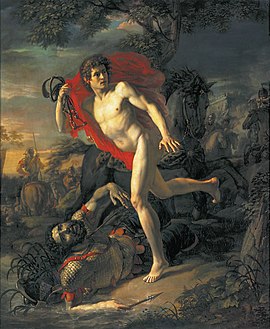Andrey Ivanov (painter)
You can help expand this article with text translated from the corresponding article in Russian. (January 2018) Click [show] for important translation instructions.
|
Andrey Ivanov | |
|---|---|
| Андрей Иванович Иванов | |
 Self-portrait (c.1800) | |
| Born | 1775 |
| Died | July 12, 1848 (aged 72–73) |
| Education | |
| Alma mater | Imperial Academy of Arts (1797) |
| Known for | History painting |
| Spouse |
Yekaterina Demert
(m. 1800; died 1843) |
| Children | 10, including Alexander Ivanov |
| Awards | |
| Elected | Member Academy of Arts (1803) Professor by rank (1812) |
Andrey Ivanovich Ivanov (Russian: Андре́й Ива́нович Ива́нов; 1775, Moscow - 24 July 1848, Saint Petersburg) was a Russian painter in the Neo-Classical style who specialized in historical scenes.[1]
Biography
[edit]He was abandoned by his parents and was raised at the Moscow Orphanage. He was enrolled in the elementary courses at the Imperial Academy of Arts in 1782, and later studied with Grigory Ugryumov[1] and Gabriel François Doyen, graduating in 1797. He began teaching there in 1798 and became an Academician in 1803. During this time, he was engaged in copying the old Italian masters and painting icons. In 1812 he was appointed a Professor[2] for his painting of Prince Mstislav the Brave and the defeat of Rededya.[1] In 1820, he painted the fresco "Minerva Hovering in the Sky" for the iron staircase at the Academy.
His painting "The Death of General Kulnev" angered Tsar Nicholas I when it was exhibited in 1830,[2] apparently because it portrayed a controversial (and almost certainly apocryphal) moment from the incident; Kulnev's order to his allied officers to remove their insignia so the enemy wouldn't know that the Russian army was without a commander. As a result, Ivanov was removed from the Academy.[2] A few years later, when Karl Bryullov returned to Russia and was presented with a laurel wreath, he took it off his head and placed it on Ivanov's instead, as a sign of respect and appreciation.[citation needed]
Despite his forced retirement, Ivanov remained active as a painter and member of several artistic societies. He died of cholera.[2] His grave in the Smolensk Cemetery has not survived. His son was the painter Alexander Andreyevich Ivanov.
Selected paintings
[edit]-
Prince Mstislav defeating Rededya
-
Adam and Eve
with their children -
The christening of
Grand Duke Vladimir -
The Young Hero from Kiev
References
[edit]- ^ a b c Wikisource (Russian): Biography from the Brockhaus and Efron Encyclopedic Dictionary by Andrei Somov
- ^ a b c d RusArtNet: Biography
Further reading
[edit]- Korovkevich, Sofya V. (1972). Андрей Иванович Иванов (in Russian). Moscow: Iskusstvo. OCLC 4675862.
- Moleva, Nina M. [in Russian] (1962). "Андрей Иванов, Алексей Егоров, Василий Шебуев". Выдающиеся русские художники-педагоги (in Russian). Moscow: Academy of Arts of the USSR. pp. 72–135. OCLC 874078094.
- Savinov, Alexei N. [in Russian] (1954). "Андрей Иванович Иванов". In Leonov, Alexei I. (ed.). Русское искусство: очерки о жизни и творчестве художников. Первая половина девятнадцатого века (in Russian). Moscow: Iskusstvo. pp. 9–26. OCLC 489749250.
- Sobko, Nikolai P. [in Russian] (1895). "Иванов, Андрей Иванович". Словарь русских художников (in Russian). Vol. 2. Saint Petersburg: M. Stasyulevich. cols. 301–319. OCLC 889716402.
External links
[edit]![]() Media related to Andrey Ivanovich Ivanov at Wikimedia Commons
Media related to Andrey Ivanovich Ivanov at Wikimedia Commons
- Andrey Ivanovich Ivanov at the Russian Academy of Arts' official website (in Russian)
- Imperial Academy of Arts alumni
- Awarded with a large gold medal of the Academy of Arts
- Members of the Imperial Academy of Arts
- Academic staff of the Imperial Academy of Arts
- Painters from the Russian Empire
- Male painters from the Russian Empire
- Russian history painters
- 1775 births
- 1848 deaths
- Burials at Smolensky Cemetery
- Deaths from cholera




